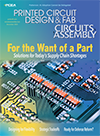Getting Lean
 A positive counterbalance for mitigating inflation.
A positive counterbalance for mitigating inflation.
Ideally, design for excellence (DFx) should optimize and standardize every product and associated manufacturing processes to achieve high throughput and eliminate defect opportunities. While Lean original equipment manufacturers (OEMs) may reach those lofty goals in their facilities, electronics manufacturing services (EMS) environments rarely achieve them. In these environments, OEMs control their designs and much, if not all, of their approved material list (AML).
 Focusing on fundamentals to drive world-class quality and throughput.
Focusing on fundamentals to drive world-class quality and throughput.
Most electronic products incorporate surface mount technology (SMT). Consequently, it is a critical process to monitor in terms of quality and cost. Lean manufacturing principles provide a solid foundation for eliminating the variation that can create defect opportunities as well as methodologies for improving throughput. Lean manufacturing-related philosophies in SigmaTron International’s facility in Tijuana, Mexico, include good manufacturing practices (GMPs), the single-minute exchange of die (SMED) methodology and total productive maintenance (TPM).
 A Lean solution for high-mix production environments.
A Lean solution for high-mix production environments.
In any manufacturing process, first article inspection (FAI) plays a crucial role in validating initial assumptions about product design, manufacturability, materials, process design, machine programming and process control. This validation ensures consistency before the production of the product in volume. In the electronics manufacturing services (EMS) world, this process is often more complex because of the number of parties involved.
 How a novel approach can take time from 2 minutes to 2 seconds.
How a novel approach can take time from 2 minutes to 2 seconds.
Poka-yoke is a Japanese term meaning mistake proofing. It was introduced by Shigeo Shingo as part of the Toyota Production System (TPS) and refers to simple fixes that address small variances in the manufacturing process.
Even production operations that focus on best practices in new product introduction (NPI) require poka-yokes. For example, SigmaTron International’s Tijuana, Mexico facility applies Advanced Product Quality Planning (APQP) and conducts failure mode and effects analysis (FMEA) to establish the most efficient, defect-free process. The facility utilizes a product part approval process (PPAP) for automotive projects to validate the process, while customer-specific validation processes apply to projects in other industries. Once production begins, the team monitors processes and tracks defects using statistical process control (SPC) and other forms of quality data collection. When defects occur, the team schedules a kaizen event, employing tools such as 8D problem solving, Six Sigma’s define-measure-analyze-improve-control (DMAIC) and poka-yoke to analyze and correct the root cause.
Using Lean Six Sigma to prioritize projects, optimize capex, and inform employee recognition.
Lean Six Sigma is a powerful tool for production teams committed to continuous improvement. Viewed as individual activities, however, the overall impact of the improvements it drives may not be obvious. The Continuous Improvement teams in SigmaTron International’s Tijuana, Mexico, facility address this with an annual review meeting that looks both at accomplishments over the past year and year-over-year trends. The top three teams are recognized for their accomplishments.
 Respinning a board to eliminate PTH parts can pay off in production.
Respinning a board to eliminate PTH parts can pay off in production.
When an electronics manufacturing services (EMS) provider is involved in developing a new product, it is easy to provide design for excellence (DfX) recommendations that align with Lean manufacturing philosophy.
Addressing manufacturability or testability issues associated with legacy products is much more challenging, however. The reasons printed circuit board layout or product design choices may not be optimal are many. Design cycles have been compressed and design resources have been cut at many OEMs. When layout or product development is outsourced to a third-party design team without manufacturing familiarity, the result may be a PCB assembly (PCBA) that meets form, fit, function and cost recommendations, but ignores industry standard design rules, sole sources much of the bill of materials (BoM) or requires unnecessary processing.
SigmaTron’s new product introduction (NPI) process evaluates these issues as new projects are onboarded through a combination of an engineering team review and automated checks through a third-party design tool. When improvement opportunities are identified, the team can provide redesign or PCB layout services to correct the issues.


